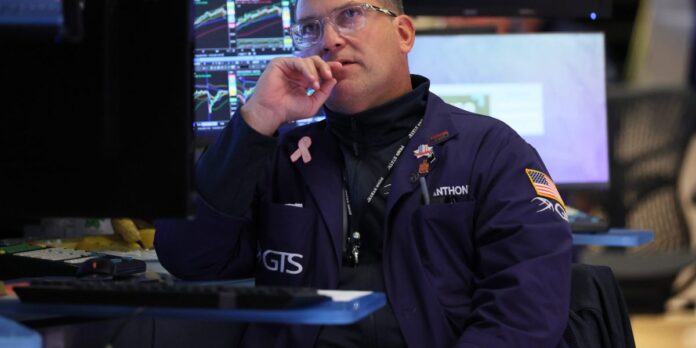Bank of America Research has issued a fresh warning for equity investors: the S&P 500, now hovering near historic highs, is demonstrating elevated risk levels with 60% of the firm’s proprietary “bear market signposts” flashing red—just shy of the point that has historically heralded a market peak. The bank’s S&P 500 Relative Value Cheat Sheet, published Monday, reflected growing caution among the team led by Head of U.S. Equity Strategy Savita Subramanian.
Subramanian’s team argued that investors should be increasingly selective, as the broad index has become “statistically expensive on everything.” All 20 of the valuation metrics tracked by her team are at expensive levels, and in fact have never been more expensive in several key areas, including market cap to GDP. The S&P 500 is also trading above its Tech Bubble levels on nine different metrics, Subramanian’s team noted.
BofA’s methodology tracks 10 signals that tend to precede cyclical market tops. Currently, six out of these ten are triggered, including elevated price-to-earnings ratios, extreme outperformance of high-multiple stocks compared to cheaper ones, and loosening credit conditions. Historically, major market peaks have occurred when roughly 70% of these indicators were triggered, making today’s 60% worryingly close. According to BofA’s strategists, these “bear market signposts — the triggers that typically precede an S&P 500 peak — suggest additional caution.”
Subramanian is far from the only analyst urging caution. Morgan Stanley Wealth Management CIO Lisa Shalett told Fortune earlier this month she was concerned about a “Cisco moment,” like when the dotcom bubble burst and that stock lost 80% almost overnight. She highlighted that artificial intelligence (AI) has almost a total grip on the S&P 500, accounting for 75% of gains, 80% of profits and 90% of capex since the rally of the last few years began. She added she isn’t concerned about the next nine months, per se, but “very concerned” about what comes after that.
BofA’s semiconductors analyst Vivek Arya was more sanguine, arguing to Fortune that companies are more anxious about maintaining 2025’s robust capex levels than about an imminent downturn. Still, Arya said he was confident about both the next 12 months and the next five years, but “can there be periods of digestion in between? Yeah.”
Market drivers and emerging risks
The new BofA report also highlights possible cracks beneath the market’s surface. While recent gains have been propelled by resilience in mega-cap tech stocks and the enduring strength of the U.S. consumer, strategists warn that these drivers could be at odds. For example, artificial intelligence—one of the market’s hottest themes—could reduce demand for professional services, potentially impacting an area that has driven much of the consumption growth since the 1980s.
Subramanian previously told Fortune that she sees AI as key to resolving the famous “productivity paradox” identified by Nobel laureate Robert Solow: the idea that computers are visible everywhere, except in productivity statistics. She said she’s seeing hints in data going back to roughly 2022 that S&P 500 firms have learned how to work harder and smarter, often replacing people with process. “A process is almost free and it’s replicable for eternity,” she said, adding it’s a more complex story than AI displacing workers, but a fundamental shift in how business is being done.
Still, she warned in October that risks are mounting in the rapidly evolving world of private lending. Since the 2008 financial crisis, non-bank lenders have supplanted traditional banks, and instability in private credit could force pension funds and other large investors to sell S&P 500 index funds, potentially exacerbating volatility. The domination of passive investing further increases concerns—should these asset owners turn to selling, liquidity in the S&P 500 could dry up with alarming speed.
Subramanian spotlighted the AI sector, writing that “AI funding has formed a Gordian [sic] knot involving mega caps, transfer payments, even the US government,” referring to the famous legend about how Alexander the Great was faced with a knot so tangled that he had no point except to cut through it with a sword. The U.S. government’s involvement with taking an equity stake in Intel, for instance, and Nvidia’s centrality to the story, were other allusions. Subramanian said this is “not a risk in itself but a complicating factor.”
October’s unexpected U.S. government shutdown and renewed trade tensions with China have added fog to an already hazy macroeconomic environment, slowing both project planning and economic activity. BofA also points to a record 54% of investors who now believe that AI stocks are in a bubble, according to its most recent Global Fund Manager Survey—another reason for heightened vigilance around the market’s uneasy exuberance.
As investors stare down a market where euphoria and real risk walk hand-in-hand, BofA’s 60% bear signpost warning serves as a timely reminder: cycle tops may only become obvious in hindsight, but the flashing risk signals are here now.
Disclaimer : This story is auto aggregated by a computer programme and has not been created or edited by DOWNTHENEWS. Publisher: fortune.com






